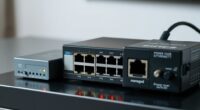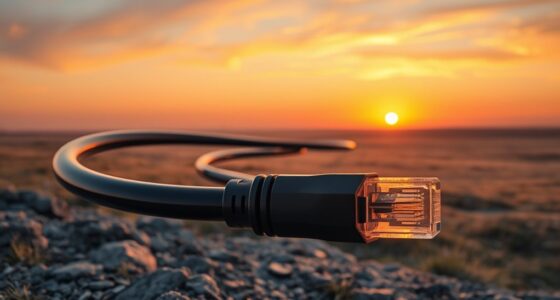Understanding cable category ratings from Cat5e to Cat8 helps you select the right Ethernet cable for your network needs. Each category offers different speeds, bandwidths, and shielding features. For example, Cat5e supports up to 1 Gbps, while Cat8 can handle 40 Gbps. Knowing these differences guarantees you pick the right cable for your setup and future upgrades. If you explore further, you’ll discover how to choose the best cable for your environment.
Key Takeaways
- Cable categories like Cat5e to Cat8 indicate increasing performance levels, bandwidth capacities, and supported data transfer speeds.
- Higher categories feature improved shielding and construction to reduce interference and crosstalk, enhancing signal integrity.
- Category ratings determine maximum supported speeds; for example, Cat5e up to 1 Gbps, Cat6 up to 10 Gbps, and Cat8 up to 40 Gbps.
- Selecting the appropriate category ensures compatibility with current and future network requirements, optimizing performance.
- Upgrading to higher categories provides better future-proofing for growing bandwidth demands and advanced technological applications.
Overview of Ethernet Cable Categories

Have you ever wondered how Ethernet cables are classified for different networking needs? Ethernet cables primarily consist of twisted pair wiring, which helps reduce electromagnetic interference and crosstalk. The categories, from Cat5e to Cat8, specify the performance and suitability for various applications. Each category features different shielding types, such as unshielded twisted pair (UTP), shielded twisted pair (STP), or foil-shielded twisted pair (FTP). UTP cables are common for everyday use, offering flexibility and affordability. Shielded types provide extra protection against interference, making them suitable for environments with high electromagnetic noise. These classifications help you choose the right cable based on your network’s requirements, balancing cost, flexibility, and interference resistance. Additionally, cable category ratings also influence the maximum transmission speeds and distances supported by the network. Understanding network performance standards ensures optimal setup for both home and enterprise systems. Properly selecting the correct category can also impact future-proofing your network, ensuring compatibility with emerging technologies and higher data demands. A comprehensive understanding of cable specifications can help prevent bottlenecks and ensure reliable connectivity as your network grows.
Differences in Speed and Bandwidth Capabilities

Understanding the differences in speed and bandwidth capabilities among Ethernet cable categories is essential for ensuring your network performs ideally. The speed comparison between categories shows how quickly data can be transmitted, with higher categories offering faster transfer rates. For example, Cat5e supports speeds up to 1 Gbps, while Cat6 reaches 10 Gbps over shorter distances. Moving to higher categories, Cat7 and Cat8 offer even greater speeds and bandwidths, with Cat8 supporting up to 25 or 40 Gbps. The bandwidth differences are also significant; newer categories provide wider bandwidths, allowing more data to flow simultaneously. This means your network can handle higher traffic loads and support demanding applications, ensuring smoother streaming, gaming, and data transfer experiences. Additionally, understanding category ratings can help you choose the right cable for specific network needs and future-proof your setup. Considering the network requirements of your devices and applications can help you select the most appropriate cable category to optimize performance and longevity. Recognizing performance standards is crucial in selecting cables that meet the necessary specifications for your network’s reliability and speed. A thorough understanding of cable construction can also influence durability and interference resistance, further enhancing network stability.
Construction and Shielding Features

The construction and shielding features of Ethernet cables play a crucial role in protecting your network from interference and maintaining signal integrity. Most cables use twisted pair conductors, which help reduce electromagnetic interference by twisting wires together at consistent intervals. Higher-category cables often incorporate foil shielding around each twisted pair or around the entire bundle, providing an extra barrier against external noise. This shielding minimizes crosstalk and signal degradation, especially in environments with high electrical interference. The combination of twisted pairs and foil shielding ensures your connection remains stable and fast. When selecting cables, consider the shielding type to match your environment’s interference levels. Proper construction and shielding are essential for reliable, high-performance network connections across different cable categories.
Typical Use Cases for Each Category

You’ll find that different cable categories are suited for specific environments. Residential network setups typically use cables rated for lower levels of interference, while data centers require high-performance cables capable of handling large data loads. Understanding these use cases helps you choose the right cable for each application to guarantee the best performance. Additionally, selecting appropriate cables can also contribute to a more organized and efficient network infrastructure.
Residential Network Applications
Ever wonder which cable ratings are best suited for your home network needs? For most households, Cat5e and Cat6 cables handle everyday tasks like streaming, gaming, and browsing. They support fast internet speeds and are cost-effective for indoor use. If you’re considering outdoor setups or long runs outside your house, look for cables with outdoor durability, which resist moisture and UV rays. While wireless alternatives are convenient, wired connections ensure stability for high-bandwidth activities. For smart home devices, security cameras, or outdoor entertainment zones, choosing cables with appropriate ratings helps guarantee reliable connections and longevity. Cat7 and Cat8 are more future-proof but often overkill for typical residential applications. Focus on your specific needs, and select a cable that balances performance, outdoor durability, and budget. Additionally, understanding cable category ratings can help you make informed decisions that optimize your network’s performance and reliability. Investing in the right cable quality can also prevent future connectivity issues and improve overall network stability. Being aware of your residential network applications ensures you pick the most suitable cables for your home environment.
Data Center Environments
Choosing the right cable category for data center environments depends on the specific performance requirements and scale of the infrastructure. For high-speed, reliable connections, Cat6a or Cat8 cables are common, supporting data rates up to 40 Gbps. However, fiber optics often serve as the backbone due to their superior bandwidth and distance capabilities, reducing latency and interference. In smaller data centers, Cat5e or Cat6 cables may suffice for less demanding applications. [Vetted cable options] are available to meet various needs and environments. Additionally, considering cable category ratings can help optimize network reliability and performance in specific settings. Understanding the environment helps determine whether to prioritize cable categories or incorporate fiber optics for core infrastructure, ensuring ideal performance, scalability, and future-proofing of your data center.
Compatibility and Future-Proofing Considerations

When selecting a cable, considering compatibility with your devices and future-proofing your setup is vital. Think about how well the cable supports wireless integration, especially if you plan to connect smart devices or Wi-Fi access points. Outdoor durability is also essential if your cables will run outside or in harsh environments, guaranteeing longevity and reliability. To help you decide, consider these points:
- Confirm the cable’s ratings match your current and future network speeds.
- Ensure compatibility with your existing hardware, like switches and routers.
- Check if the cable offers outdoor durability for outdoor or exposed installations.
- Plan for future upgrades by choosing higher-rated cables, like Cat6a or Cat8, to stay ahead of evolving technology needs.
- Practicing self-awareness about your network needs can help you select the most suitable cable for your specific environment and goals.
- Understanding cable category ratings can provide insights into the cable’s ability to support higher bandwidths and emerging technologies.
Installation Tips for Optimal Performance

To guarantee your network performs at its best, proper installation practices are essential. Start by selecting the right connector types for your cables, ensuring compatibility with your network devices. Use quality installation tools like crimpers, cable strippers, and testers to secure connections and prevent faults. Keep cables organized and avoid tight bends, which can degrade signal quality. When installing, follow manufacturer guidelines for cable depth and separation from electrical interference sources. Label each cable for easy troubleshooting later. Proper termination of connectors is crucial; use the correct tools to ensure secure, clean connections. Avoid excessive pulling or stretching, which can damage the cable. Additionally, understanding the trends in healthcare and wellness can inspire more holistic and health-conscious network solutions. For optimal performance, consider the correct cable category suited to your specific needs, as higher categories often support faster speeds and better shielding. Using proper grounding practices can also prevent electrical interference and improve network stability. Incorporating the latest installation techniques can further enhance the durability and reliability of your cabling system. Following these tips will help you achieve excellent performance and longevity from your network cabling system.
Choosing the Right Cable for Your Network Needs

Selecting the right network cable is essential to guarantee your system meets performance, speed, and reliability requirements. When choosing, consider your current needs and future growth. Wireless alternatives might seem tempting, but cables offer stability and higher speeds for demanding tasks. To help decide, consider these:
- Network Speed Requirements: Opt for higher-category cables like Cat6 or Cat8 for faster data transfer.
- Cable Installation Costs: Lower-cost cables may suffice for basic setups, but higher-rated cables can reduce long-term expenses through improved performance.
- Distance and Interference: Longer runs or noisy environments benefit from shielded cables.
- Future-Proofing: Investing in higher-category cables now guarantees compatibility with upcoming technology. Additionally, understanding the Nutritional Advantages of Green Juice can be essential when considering health-conscious choices in your lifestyle. Considering the Starting & Managing Payment Services in various industries can also provide insights into choosing reliable infrastructure solutions.
Choosing wisely balances upfront costs with performance, making wired connections a reliable choice over wireless alternatives for critical applications.
Frequently Asked Questions
How Do Environmental Factors Affect Cable Performance Over Time?
Environmental factors like weather resilience and temperature effects can crucially impact your cable’s performance over time. Exposure to extreme temperatures causes the insulation to degrade, leading to signal loss or interference. Moisture and humidity can cause corrosion and short circuits. To guarantee reliable performance, you should choose cables rated for your environment and protect them from harsh weather conditions, maintaining ideal signal quality and extending their lifespan.
Are There Differences in Cost-Effectiveness Among Cable Categories?
You’ll find that Cat5e cables are typically the most cost-effective, with a price that’s about 30% lower than Cat8 options. When you compare the cost, installation expenses also matter—higher-category cables often require specialized tools and more careful handling, which can increase your overall costs. So, if your project doesn’t demand ultra-high speeds, opting for lower categories can save you money both upfront and in the long run.
Can Older Networking Equipment Support Higher Category Cables?
Older networking equipment typically can’t support higher category cables like Cat6 or above due to compatibility issues. You might face retrofit challenges, as upgrading cables alone won’t improve performance if your hardware can’t handle higher speeds or bandwidth. It’s crucial to verify your equipment’s specifications before upgrading cables, guaranteeing compatibility to avoid unnecessary costs or installation problems. Upgrading both your hardware and cables ensures ideal network performance.
What Are the Signs Indicating a Cable Needs Replacement?
You’ll know your cable needs replacing if you notice signs of cable aging, such as frayed or cracked insulation, or if it shows physical damage like cuts or burns. Reduced performance, frequent disconnections, or slower speeds also indicate deterioration. Don’t ignore these signs, as damaged cables can cause network issues and pose safety risks. Replacing worn or damaged cables guarantees your network stays dependable and maintains peak performance.
How Do Cable Length and Quality Impact Signal Integrity?
Oh, the joy of choosing the right cable length and quality! Longer cables can weaken signals, causing frustration, while high-quality cables with good shielding effectiveness guarantee your data stays intact. Poor quality cables or incompatible connectors lead to signal degradation and connectivity issues. So, keep your cables short if possible, pick ones with proper shielding, and verify connector compatibility to maintain strong, reliable signals without the irony of constant troubleshooting.
Conclusion
Choosing the right Ethernet cable isn’t just about speed; it’s about anticipating your future needs and making smart choices now. As technology evolves, your cable’s category can become a vital link or a limiting factor—kind of like how the right shoes can make all the difference in a long walk. So, take a moment to reflect on your current setup and future plans. After all, a well-chosen cable can surprisingly become the foundation of your seamless network experience.









